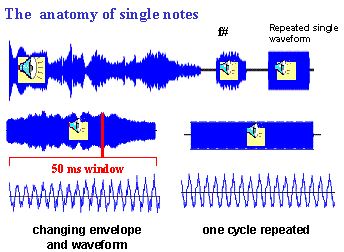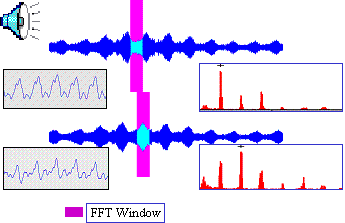Colin Gough - c.gough@bham.ac.uk
School of Physics and Astronomy
University of BirminghamK
Birmingham, B15 2TT,UK
Popular version of paper 4pMU1
Presented Thursday afternoon, November 13th, 2003
146th ASA Meeting, Austin, TX
For well over 150 years scientists have been trying to understand what physical
properties distinguish a fine Stradivarius violin from the kind of violin sold
in your typical local music store. The problem lies in knowing what to look
for. Leading international soloists and chamber music players almost invariably
use old Italian violins rather than modern instruments. If there really is a
difference that sets instruments made by famous Italian violin makers of the
17th and 18th century apart from their modern counterparts, there must be a
rational, scientific reason. But definitive explanations remain illusive.
In this paper, we show that vibrato is an essential ingredient in defining the
sound of a violin and presumably its quality also. We examine both the perceptual
importance of vibrato and the acoustical properties of a violin likely to enhance
the response of a violin played with vibrato.
Vibrato involves the periodic rocking backwards and forward of the players
finger on the stopped string. All modern soloists use an almost continuous wide-amplitude
vibrato to enhance the quality of the tone they produce, although many classical
and baroque purists decry its use. Nevertheless, for the modern performer, the
responsiveness of an instrument to the use of vibrato is undoubtedly one of
the key factors in assessing a violin's tone quality.

|
The importance of vibrato will be illustrated by taking the sound of a fine instrument played by an international soloist (a commercial recording of Perlmann playing the opening exposition of the Max Bruch Violin Concerto) and repeating a single period of the penultimate note indefinitely. See the accompanying below and listen to Sound 1 for a comparison of the derived and real sounds. The derived sound, from what is almost certainly an instrument worth well in excess of $1M, is indistinguishable from that of a $30 signal generator! Much the same kind of totally uninteresting and unmemorable sound is produced by any physicist's model of the violin with a constant bowing input. |
The time-varying fluctuations in sound arising from the use of vibrato - and possibly noise from the bow sliding across the string - must therefore be essential ingredients in defining the sound of a violin and hence of its quality also.
At typical vibrato frequencies of around 5-6 cycles a second, the listener
cannot distinguish changes in frequency from changes in amplitude. It also comes
as quite a surprise, even to the player, that vibrato induces much larger changes
in amplitude than in frequency of the rather complex waveforms of sound generated
by the bowed violin. We relate such changes to the acoustical characteristics
of the violin and to the quality of the wood used in its construction.
The violin is rather like a loudspeaker, with the bowed string providing the
input and the body of the instrument acting like a loudspeaker unit radiating
sound. Unlike a loudspeaker, where the response is designed to be as smooth
as possible at all frequencies, the frequency response of a violin is very jagged
with many peaks and troughs. These arise from the large number of resonances
of the violin structure. The frequency response of a violin provides us with
an acoustical fingerprint, with the positions and amplitudes of individual
resonances defining a particular violin. However, apart from the very broadest
of features, it is often difficult to distinguish a really fine violin from
a mediocre instrument from such fingerprints.
When a string is bowed at a particular pitch, it excites the violin at a great
number of frequencies at integer multiples of the played note (e,g, when played
at a pitch of 300 Hz, the violin is also excited at 600, 900, 1200...Hz with
up to around 40 such harmonics). When vibrato is used, each of these harmonics
slides up and down the large peaks and troughs of the frequency response. The
radiated sound is therefore always changing, with very large periodic changes
in amplitude of individual frequency components and waveforms.
 |
This is demonstrated by the recorded waveform and associated sound file Sound 2 illustrating the "anatomy" of single note. The player, Tasmin Little, keeps returning to this particular note, D on the G-string, to illustrate the "exciting, fantastic, wonderful, vibrant, it's alive" tone of Milstein's outstanding Stradivarius violin (a recorded BBC interview). The use of vibrato leads to massive periodic changes in amplitude and continuous changes in waveform and spectrum of the harmonics excited, as shown in the time-expanded highlighted sections. |
We conclude that vibrato must play an essential role in the modern soloist's
perception of the quality of a violin. Even in early music, small fluctuations
in bow pressure, the minimal use of vibrato and inevitable finger wobble helps
to distinguish the violin from other continuously sounded instruments, such
as the baroque oboe or even a simple electronic synthesiser.
Indeed, vibrato provides a continuously changing sensation to the ear. This
holds the listeners attention and helps to distinguish a solo instrument from
the sounds made by any surrounding players even a large symphony orchestra.
The ubiquitous use of a large amplitude vibrato by the modern soloist is therefore
scarcely surprising. The responsiveness of a violin to the use of vibrato must
therefore also be important in defining the quality of an instrument played
in the concert hall. The quality of the wood used in the construction of the
violin and the spacing of its resonances are shown be two important physical
properties of the violin that affects an instrument's response to vibrato and
presumably therefore of its quality also.